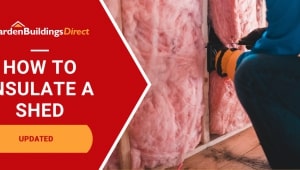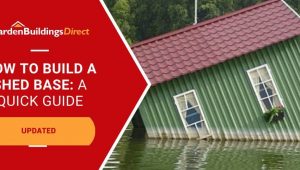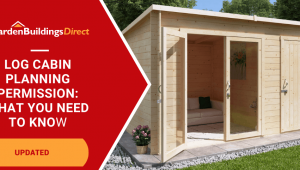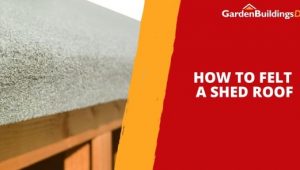Jump to:
Choosing the right type and size of greenhouse is key to growing tomatoes at home. Here’s how to find one with the right temperature, humidity management, and enough space.
The choice of materials affects insulation and durability. Common options in the market include:
- Wooden greenhouses top the list thanks to their natural thermal properties. The only downside is the maintenance they require to combat rot and pests.
- Metal greenhouses, such as aluminium, are durable and low maintenance. However, they don’t tend to hold the warmth over time as much as wooden greenhouses. Overall, they can withstand harsh conditions while providing a long-lasting structure.
- Polycarbonate greenhouses (as an alternative to traditional glass) offer superior insulation by trapping heat between layers. Their shatterproof panels also enhance durability, making them resistant to weather damage. These can be available with either wooden or metal frames.
The key things that guarantee successful tomato growth are:
- maintaining a good temperature (not too hot, not too cold)
- ventilation to control humidity
- having enough space
With that in mind, let’s look at some models.
The Best Greenhouses for Growing Tomatoes: Expert Picks
Let’s look first at the BillyOh Rosette Hobby Aluminium Greenhouse.
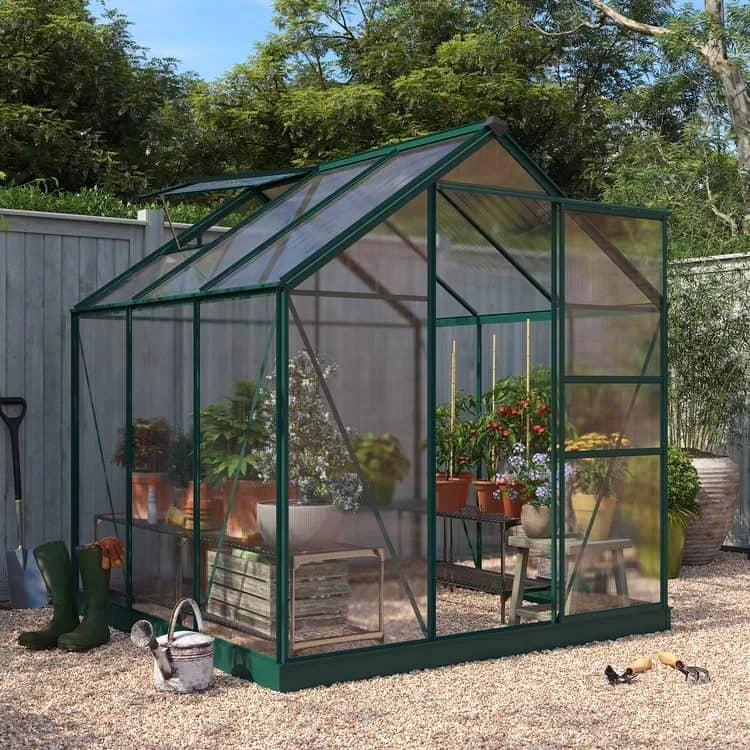
As a metal greenhouse, this one is extremely accessible and low maintenance. Its styrene glazing helps it to warm up quickly, providing a temperature that your tomato plants will love. Plus, it has a roof window you can open for ventilation if the humidity starts to get too high.
It’s available in a single size of 6×4 feet, which makes it a nice medium-sized greenhouse. This is enough space for up to 6 tomato plants across each of the long sides.
Why it’s ideal for tomatoes:
Low Maintenance: The aluminium frame resists rust and doesn’t require treatment, making this a convenient option for busy gardeners.
Good Ventilation: Equipped with roof vents, it allows for proper airflow to manage humidity—crucial for healthy tomato plants.
Lightweight Design: While not as naturally insulative as timber, you can enhance warmth by adding bubble wrap insulation or thermal mass (like water barrels or dark paving slabs).
Ideal for Summer Crops: If you’re growing tomatoes mainly during warmer months, the Rosette is more than capable of providing the right environment.
However, there are some other greenhouses you should consider before you make your choice…
The BillyOh 4000 Lincoln Wooden Greenhouse with Roof Vents is one of the most popular wooden greenhouses on the market. Its timber frame helps to hold in the heat alongside watertight tongue and groove cladding. The glazing itself is twin-walled polycarbonate, creating an obscured effect. Wood is also great for customising the look and adding accessories.
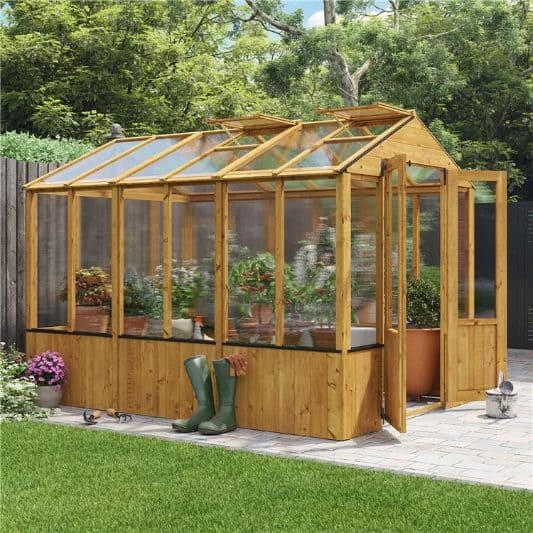
Lincoln greenhouses are available in multiple sizes, with this one having up to 2 opening roof vents to help you control the environment inside. You can go as small as 3×6 feet with this one, if you only want a few plants or have limited garden space.
There is also a clear wall greenhouse edition of the Lincoln if you want an unobscured view of your plants from the outside, although this isn’t quite as insulating.
Why it’s ideal for tomatoes:
Natural Insulation: The timber construction of the Lincoln Greenhouse retains heat exceptionally well—ideal for keeping temperatures within the 21–27°C (70–80°F) range tomatoes need during the day.
Ventilation Control: Built-in roof vents help regulate the internal environment. You can open these on hot days to prevent overheating and excess humidity, then close them to retain warmth overnight.
Sturdy Structure: Wood’s thermal mass provides stability against temperature fluctuations, protecting sensitive tomato seedlings early in the season.
Maintenance Tip: Wood requires regular care (such as sealing or painting) to prevent rot, but its warmth-retention benefits are unmatched.
Then there’s the BillyOh Switch Greenhouse. There are a couple of unique qualities to this one.
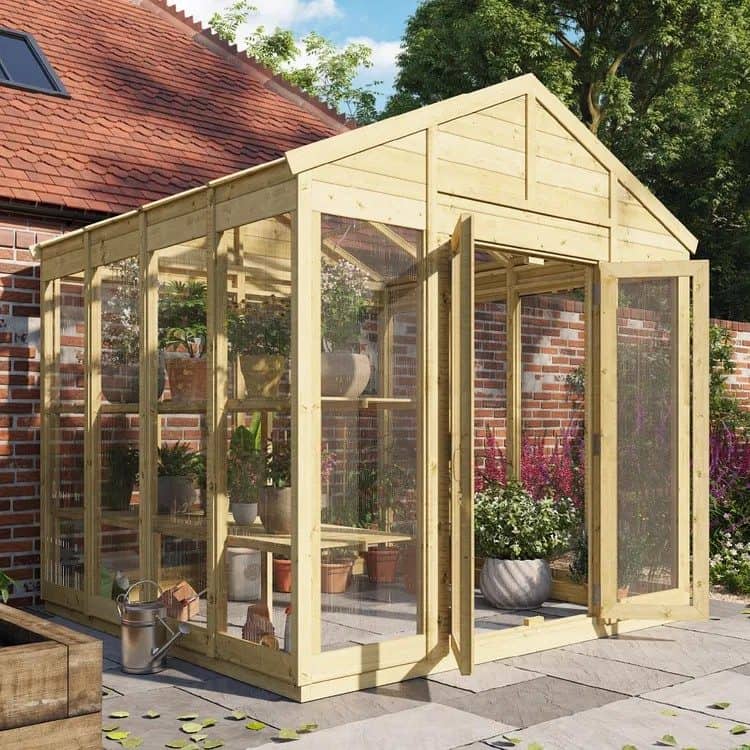
First of all, it comes already protected with pressure treatment. This means the timber has been put through a machine that forces wood preservative into its fibres under high pressure, which provides extremely deep protection against moisture.
Then there’s the modular design, which enables you to choose where each panel is placed. Above, you can see the greenhouse with the doors positioned under the gable on the front. But you can also position the doors anywhere along the sides, like this:
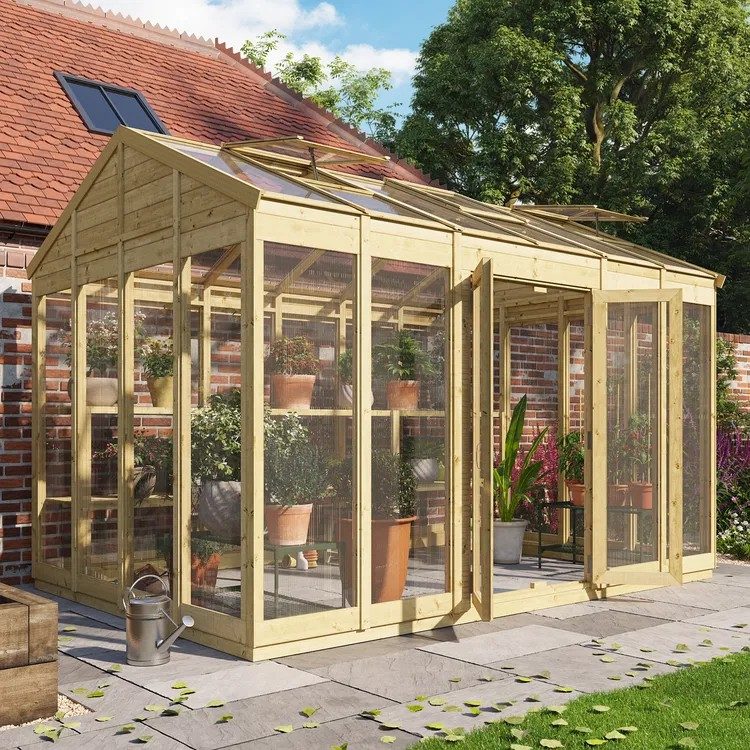
This means your Switch greenhouse can be adapted to your garden layout. So if you need the doors near the corners for easy access, you can do that.
Why it’s ideal for tomatoes:
Pressure-Treated Timber: Offers the same heat-retentive benefits as natural wood, but with built-in resistance to rot and decay—perfect for long-term performance.
Roof Vents: Promote excellent air circulation, which is vital to keeping humidity levels in check.
Modular Design: A standout feature—the Switch Greenhouse allows you to customise door placement, enabling optimal orientation to suit your garden layout, prevailing winds, or sun exposure. This helps you better regulate internal conditions for tomatoes.
Flexible Layout: Whether you’re working in a compact space or planning a larger setup, the modular structure adapts to your needs.
In Summary: It’s a greenhouse that combines warmth, resilience, and personalisation—ideal for serious tomato growers.
If you need to find out more about greenhouses, look no further than our greenhouse buying guide.
Ready to start planting tomatoes? Your next item to read is: How to Grow Tomatoes in Greenhouses.
